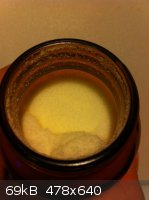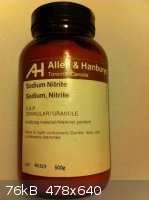dangerous amateur
Hazard to Others
  
Posts: 148
Registered: 8-7-2011
Member Is Offline
Mood: No Mood
|
|
Nitrite shelf life
Hi there,
I just got a bottle of Sodium Nitrite, wich is hard to get for normal end-consumers here because of it's toxicity.
Well, original yellow Merck bottle, 99,xx purity - very well.
But it's also obvious that this bottle is old. I don't now how old, maybe 10years.
The bottle is full and was shut tightly, the screwcap had a disk seal of what looks like pastic covered paper or something.
Now it's clear that this stuff will oxidize to Nitrate upon air contact. I don't know how quick it does happen and I could not find any information on
the internet about that.
No "best before..." information available
Even if the bottle was allways shut tight, oxygen will diffuse through the plastic for sure - but at what rate...?
I know there are procedures to check for nitrate, but the experemtal proof that there is some nitrate present doesn't help me so much...
I want to use it for diazotation, the question is, how much NaNO3 will ruin the experiment.
What do you think? Give it a try?
[Edited on 19-3-2012 by dangerous amateur]
[Edited on 22-3-2012 by ScienceSquirrel]
|
|
|
entropy51
Gone, but not forgotten
    
Posts: 1612
Registered: 30-5-2009
Member Is Offline
Mood: Fissile
|
|
For what it's worth, I bought a lifetime supply of sodium nitrite over 20 years ago. I keep it tightly capped and the cap is sealed with plastic
tape. It is stored in my basement which stays cool, below 70 F.
It still works fine in diazotizations, but I do always check them with starch-iodide paper to be sure that adequate amounts of nitrite have been
added.
I'm doubtful that significant amounts of nitrite will be oxidized to nitrate in a well sealed bottle.
|
|
|
dangerous amateur
Hazard to Others
  
Posts: 148
Registered: 8-7-2011
Member Is Offline
Mood: No Mood
|
|
Thank you for your answer, entropy.
Do you use a glas bottle? PTFE Cap?
|
|
|
woelen
Super Administrator
        
Posts: 8014
Registered: 20-8-2005
Location: Netherlands
Member Is Offline
Mood: interested
|
|
I would not worry about the quality of the nitrite. if the material still is dry, then you hardly will have any oxidation to nitrate. The route of
degradation is first absorption of water which adds a thin layer of humid material around the crystals and then in this solution there is oxidation to
nitrate.
I have a nearly 30 year old bottle of NaNO2 with a plastic screwcap and this NaNO2 still is good. I did not measure its purity, but if I add some to
lukewarm dilute sulphuric acid, then it strongly fizzles and a lot of brown gas is produced, so I expect that at least the major part of this solid
still is NaNO2.
NaNO2 (and also anhydrous Na2SO3) are easier to store than many people think. Just keep them dry in well sealed bottles. As long as they remain dry,
the deterioration will be negligable.
|
|
|
dangerous amateur
Hazard to Others
  
Posts: 148
Registered: 8-7-2011
Member Is Offline
Mood: No Mood
|
|
Well, it doesn't seem to be wet, but of course it's not perfectly dry either.
A little caked, lumpy. Just like nitrates.
I'll give it a try.
| Quote: |
a nearly 30 year old bottle of NaNO2 with a plastic screwcap |
To my knowledge the bottle itself is the weak point - if it's made from plastic.
That's why I prefer glass...
|
|
|
woelen
Super Administrator
        
Posts: 8014
Registered: 20-8-2005
Location: Netherlands
Member Is Offline
Mood: interested
|
|
The bottle I have indeed is a glass bottle, the cap is made from plastic. Actually, most of my chemicals are stored in glass bottles, except some
chemicals which are not air-sensitive at all.
|
|
|
Mailinmypocket
International Hazard
    
Posts: 1351
Registered: 12-5-2011
Member Is Offline
Mood: No Mood
|
|
Quote: Originally posted by woelen  |
I have a nearly 30 year old bottle of NaNO2 with a plastic screwcap and this NaNO2 still is good. I did not measure its purity, but if I add some to
lukewarm dilute sulphuric acid, then it strongly fizzles and a lot of brown gas is produced, so I expect that at least the major part of this solid
still is NaNO2.
NaNO2 (and also anhydrous Na2SO3) are easier to store than many people think. Just keep them dry in well sealed bottles. As long as they remain dry,
the deterioration will be negligable. |
This is my situation as well, my bottle of sodium nitrite seems quite old (although not exactly sure of the age...I'm guessing 20 years perhaps...who
knows!) and has what I think is a bakelite cap. It says to store in tightly closed containers, which I do, and it performs as it should, just keep it
well sealed and I dont think you will have any problems



[Edited on 24-3-2012 by Mailinmypocket]
|
|
|